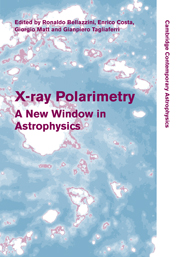Book contents
- Frontmatter
- Contents
- List of contributors
- Preface
- 1 X-ray polarimetry: historical remarks and other considerations
- Part I Polarimetry techniques
- Part II Polarized emission in X-ray sources
- 14 Probing strong gravity effects with X-ray polarimetry
- 15 X-ray polarization from black holes in the thermal state
- 16 Strong-gravity effects acting on polarization from orbiting spots
- 17 Polarization of thermal emission from accreting black holes
- 18 X-ray polarimetry and radio-quiet AGN
- 19 The soft X-ray polarization in obscured AGN
- 20 The polarization of complex X-ray sources
- 21 Polarization of Compton X-rays from jets in AGN
- 22 Polarization of X-ray lines from galaxy clusters and elliptical galaxies
- 23 Polarization characteristics of rotation-powered pulsars
- 24 Polarized X-rays from magnetized neutron stars
- 25 Polarization properties of X-ray millisecond pulsars
- 26 X-ray polarization signatures of neutron stars
- 27 Polarization from the oscillating magnetized accretion torus
- 28 X-ray polarization from accreting white dwarfs and associated systems
- 29 Polarization of pulsar wind nebulae
- 30 X-ray polarization of gamma-ray bursts
- 31 Central engine afterglow from GRBs and the polarization signature
- 32 GRB afterglow polarimetry past, present and future
- 33 Gamma-ray polarimetry with SPI
- 34 INTEGRAL/IBIS observations of the Crab nebula and GRB 041219A polarization
- 35 Fermi results on the origin of high-energy emission in pulsars
- 36 Diagnostics of the evolution of spiral galaxies in a cluster environment
- Part III Future missions
- Author index
- Subject index
14 - Probing strong gravity effects with X-ray polarimetry
from Part II - Polarized emission in X-ray sources
Published online by Cambridge University Press: 06 July 2010
- Frontmatter
- Contents
- List of contributors
- Preface
- 1 X-ray polarimetry: historical remarks and other considerations
- Part I Polarimetry techniques
- Part II Polarized emission in X-ray sources
- 14 Probing strong gravity effects with X-ray polarimetry
- 15 X-ray polarization from black holes in the thermal state
- 16 Strong-gravity effects acting on polarization from orbiting spots
- 17 Polarization of thermal emission from accreting black holes
- 18 X-ray polarimetry and radio-quiet AGN
- 19 The soft X-ray polarization in obscured AGN
- 20 The polarization of complex X-ray sources
- 21 Polarization of Compton X-rays from jets in AGN
- 22 Polarization of X-ray lines from galaxy clusters and elliptical galaxies
- 23 Polarization characteristics of rotation-powered pulsars
- 24 Polarized X-rays from magnetized neutron stars
- 25 Polarization properties of X-ray millisecond pulsars
- 26 X-ray polarization signatures of neutron stars
- 27 Polarization from the oscillating magnetized accretion torus
- 28 X-ray polarization from accreting white dwarfs and associated systems
- 29 Polarization of pulsar wind nebulae
- 30 X-ray polarization of gamma-ray bursts
- 31 Central engine afterglow from GRBs and the polarization signature
- 32 GRB afterglow polarimetry past, present and future
- 33 Gamma-ray polarimetry with SPI
- 34 INTEGRAL/IBIS observations of the Crab nebula and GRB 041219A polarization
- 35 Fermi results on the origin of high-energy emission in pulsars
- 36 Diagnostics of the evolution of spiral galaxies in a cluster environment
- Part III Future missions
- Author index
- Subject index
Summary
Light coming from the innermost regions of active galactic nuclei or galactic black hole systems is heavily influenced by the strong gravity of their central compact body. High velocities of the emitting matter also modify the properties of the light received by the detector. In this contribution the influence of the combined special and general relativistic effects on the observed intensity and polarization is summarized. The application on the systems with a geometrically thin and optically thick Keplerian accretion disc is shown.
Introduction
The light emitted in the vicinity of the compact object has different properties when absorbed by a detector at infinity. First of all the photons are usually emitted by fast-moving matter – orbiting, falling into or being ejected from the central body with very high speeds. Thus the effects of Einstein's special relativity, the Doppler shift and aberration, change the photon energy and the direction of its polarization. The beaming effect in the direction of emitting matter motion may be quite significant as well. It is worth mentioning that although these effects are those of special relativity, the high velocities causing them are due to large gravity of the central object. Therefore we need to use general relativity in order to evaluate them properly.
However, general relativity has even more direct impact on the properties of these photons. They move from a strong gravity region, often dragged along by the rotating space-time if the compact body has large angular momentum.
- Type
- Chapter
- Information
- X-ray PolarimetryA New Window in Astrophysics, pp. 95 - 102Publisher: Cambridge University PressPrint publication year: 2010
- 1
- Cited by



